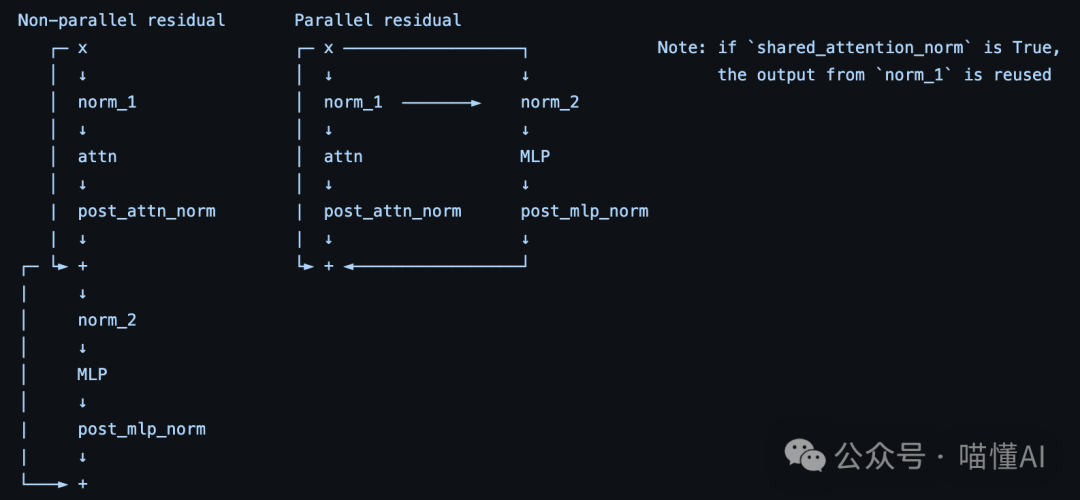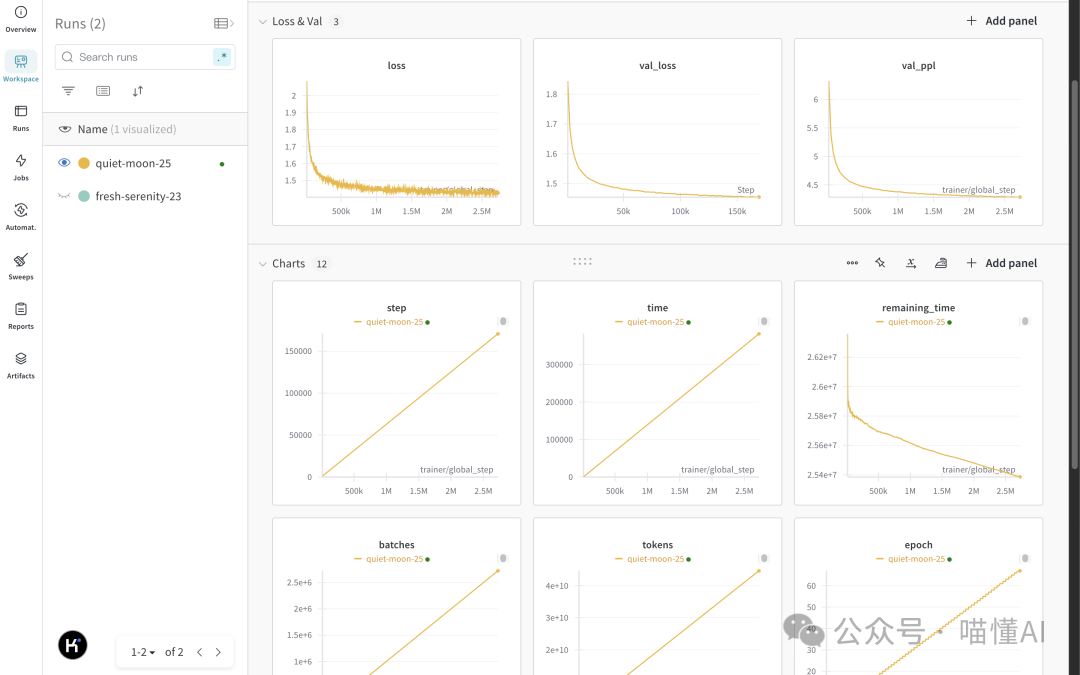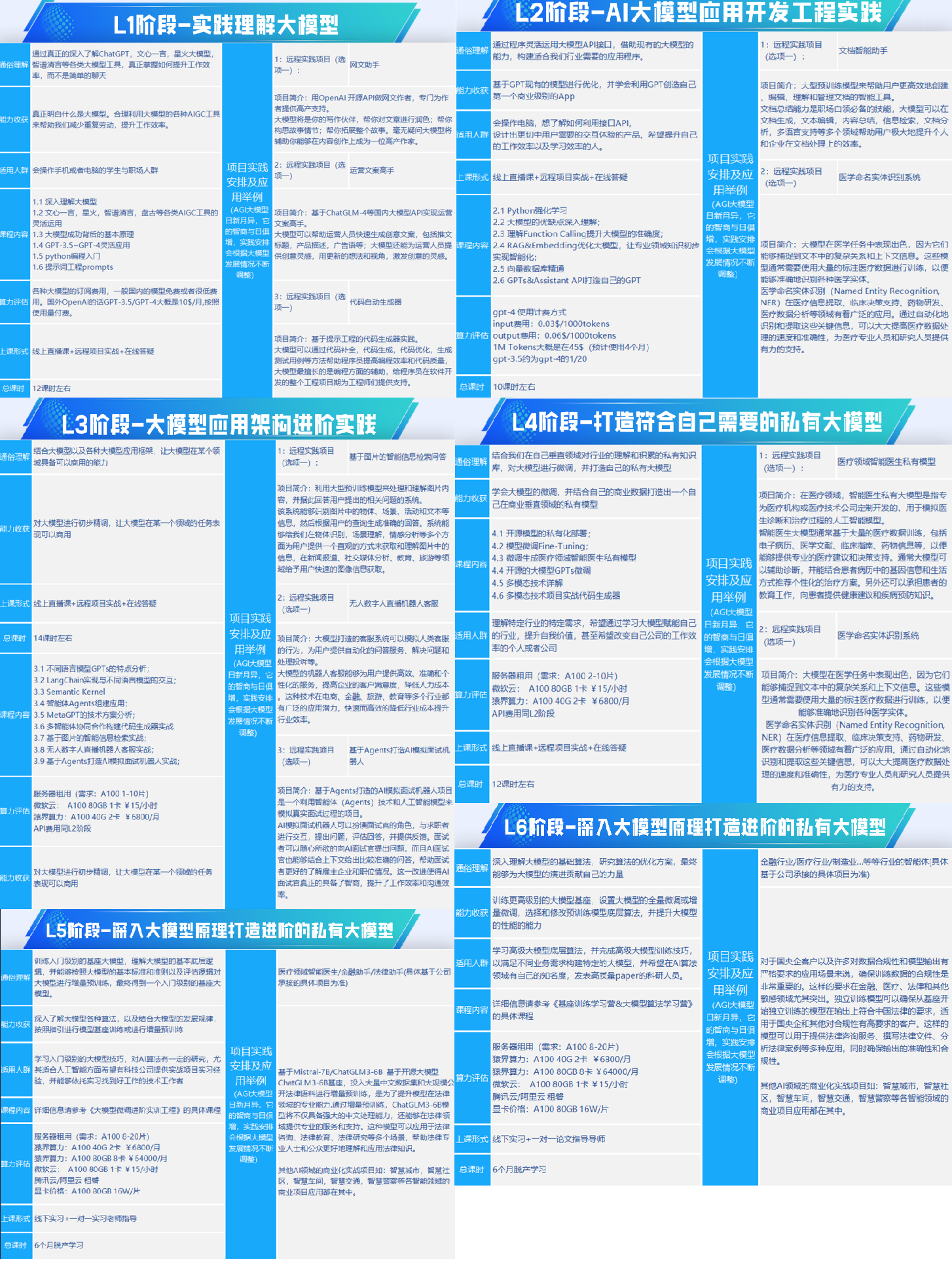今天我们来研究一下模型的配置。
litgpt使用的配置文件和transformers有点不太一样,它的仓库里提供了一些预训练所用的yaml配置文件样例[1]。这个主要用于需要自定义模型的场景。
另外litgpt也内置了一些huggingface上的现成模型[2],可以直接拿来使用。
训练配置文件
以下是我这次定义的一个配置文件。
内容有点多,但是还是都列举出来了,可以直接跳到后面对一些关键参数的解释。
# The name of the model to pretrain. Choose from names in ``litgpt.config``. Mutually exclusive with
# ``model_config``. (type: Optional[str], default: null)
model_name:microstories
# A ``litgpt.Config`` object to define the model architecture. Mutually exclusive with
# ``model_config``. (type: Optional[Config], default: null)
model_config:
name:microstories
hf_config:{}
scale_embeddings:false
block_size:512
padded_vocab_size:65024
vocab_size:64798
n_layer:6
n_head:6
n_query_groups:6
n_embd:512
head_size:48
rotary_percentage:1.0
parallel_residual:false
bias:false
norm_class_name:RMSNorm
mlp_class_name:LLaMAMLP
intermediate_size:768
# Directory in which to save checkpoints and logs. If running in a Lightning Studio Job, look for it in
# /teamspace/jobs/<job-name>/share. (type: <class 'Path'>, default: out/pretrain)
out_dir:/home/puppyapple/Server/BigAI/Chinese_LLM_From_Scratch/Experiments/Output/pretrain/microstories
# The precision to use for pretraining. Possible choices: "bf16-true", "bf16-mixed", "32-true". (type: Optional[str], default: null)
precision:bf16-mixed
# Optional path to a checkpoint directory to initialize the model from.
# Useful for continued pretraining. Mutually exclusive with ``resume``. (type: Optional[Path], default: null)
initial_checkpoint_dir:
# Path to a checkpoint directory to resume from in case training was interrupted, or ``True`` to resume
# from the latest checkpoint in ``out_dir``. An error will be raised if no checkpoint is found. Passing
# ``'auto'`` will resume from the latest checkpoint but not error if no checkpoint exists.
# (type: Union[bool, Literal["auto"], Path], default: False)
resume:true
# Data-related arguments. If not provided, the default is ``litgpt.data.TinyLlama``.
data:
# TinyStories
class_path:litgpt.data.LitData
init_args:
data_path:Chinese_LLM_From_Scratch/Data/TinyStoriesChinese/processed_data
split_names:
-train
-val
# Training-related arguments. See ``litgpt.args.TrainArgs`` for details
train:
# Number of optimizer steps between saving checkpoints (type: Optional[int], default: 1000)
save_interval:1000
# Number of iterations between logging calls (type: int, default: 1)
log_interval:1
# Number of samples between optimizer steps across data-parallel ranks (type: int, default: 512)
global_batch_size:512
# Number of samples per data-parallel rank (type: int, default: 4)
micro_batch_size:32
# Number of iterations with learning rate warmup active (type: int, default: 2000)
lr_warmup_steps:1000
# Number of epochs to train on (type: Optional[int], default: null)
epochs:
# Total number of tokens to train on (type: Optional[int], default: 3000000000000)
max_tokens:3000000000000
# Limits the number of optimizer steps to run. (type: Optional[int], default: null)
max_steps:
# Limits the length of samples. Off by default (type: Optional[int], default: null)
max_seq_length:512
# Whether to tie the embedding weights with the language modeling head weights. (type: Optional[bool], default: False)
tie_embeddings:true
# (type: Optional[float], default: 1.0)
max_norm:1.0
# (type: float, default: 4e-05)
min_lr:0.0
# Evaluation-related arguments. See ``litgpt.args.EvalArgs`` for details
eval:
# Number of optimizer steps between evaluation calls (type: int, default: 1000)
interval:2000
# Number of tokens to generate (type: Optional[int], default: null)
max_new_tokens:
# Number of iterations (type: int, default: 100)
max_iters:100
# Whether to evaluate on the validation set at the beginning of the training
initial_validation:false
# Whether to evaluate on the validation set at the end the training
final_validation:false
# Optimizer-related arguments
optimizer:
class_path:torch.optim.AdamW
init_args:
# (type: float, default: 0.001)
lr:0.0005
# (type: float, default: 0.01)
weight_decay:0.1
# (type: tuple, default: (0.9,0.999))
betas:
-0.9
-0.95
# How many devices/GPUs to use. Uses all GPUs by default. (type: Union[int, str], default: auto)
devices:auto
# How many nodes to use. (type: int, default: 1)
num_nodes:1
# Optional path to the tokenizer dir that was used for preprocessing the dataset. Only some data
# module require this. (type: Optional[Path], default: null)
tokenizer_dir:Chinese_LLM_From_Scratch/References/chatglm3-6b
# The name of the logger to send metrics to. (type: Literal['wandb', 'tensorboard', 'csv'], default: tensorboard)
logger_name:wandb
# The random seed to use for reproducibility. (type: int, default: 42)
seed: 42
model_config
model_config:
name:microstories
hf_config:{}
scale_embeddings:false
block_size:512
padded_vocab_size:65024
vocab_size:64798
n_layer:6
n_head:6
n_query_groups:6
n_embd:512
head_size:48
rotary_percentage:1.0
parallel_residual:false
bias:false
norm_class_name:RMSNorm
mlp_class_name:LLaMAMLP
intermediate_size: 768
- •
scale_embeddings控制是否对embedding进行缩放。

scale_embedding
如果为True,那么在forward函数中会对embedding进行缩放。注意这个缩放和sefl-attention中的缩放不是一回事,不要弄混了。其实也有很多讨论关于这个地方这一步是否有必要的,目前看来似乎是区别不大,可以设置为False。
-
•
transformer中的block_size,也就是max_seq_length。 -
•
padded_vovab_size和vocab_size直接取自tokenizer。 -
•
n_layer和n_head都是6,构建了一个6层6头的transformer。 -
•
n_query_groups是6,这是GQA(Grouped-Query Attention)的一个参数,控制query的分组。当n_query_groups等于n_head时,其实就是MHA(Multi-Head Attention)。下面这个图比较直观:

GQA
-
• 头的大小
head_size是48,n_embd是512。 -
•
rotary_percentage是1.0,这个是旋转编码(Rotary Position Embedding, RoPE)的有关参数,这里先不展开介绍了。 -
•
parallel_residual是false,关于parallel residual和non-parallel residual的解释可以参考这个图:

parallel_residual
-
•
bias控制Linear层的bias是否存在,现在大多模型一般都是false。 -
•
norm_class_name是RMSNorm,mlp_class_name是LLaMAMLP,具体可以参见litgpt里model.py[3]中的实现。 -
•
intermediate_size是768,这个是上面的MLP中间层的大小。
按照上面的配置得到的模型参数量在44M左右,也就是只有0.044B的大小。
但根据微软的TinyStories[4]论文结论,10-80M级别的模型能在小故事生成这种简单的语言任务上达到不错的效果(依旧能说人话)。
其他参数
其余的都是一些训练的参数,比如batch_size,lr,weight_decay等等,这些都是比较常见的参数,不再赘述。
logger我这里选择的是wandb,可以直接在wandb上查看训练过程中的一些指标。
data设置成之前预处理好的数据集的路径(其中指定了加载数据所用的litdata的类名)
tokenizer_dir是选用的或者自己训练好的tokenizer的路径。
启动训练
litgpt pretrain --config Experiments/configs/microstories.yaml
预训练启动的命令非常简单,只需要指定上面的配置文件的路径即可。
不出意外的话模型就能开始训练了,可以在wandb上查看训练过程中的指标。
我的模型其实已经训练了一段时间,show一下训练过程中的图表:

wandb
小结
-
- 详细介绍了
litgpt的预训练模型配置文件。
- 详细介绍了
-
2. 顺带解释了一些重要参数的原理。
-
3. 训练启动。
Day04的内容就到这了。积少才能成多,每次进步一点点就够了。
如何学习AI大模型?
作为一名热心肠的互联网老兵,我决定把宝贵的AI知识分享给大家。 至于能学习到多少就看你的学习毅力和能力了 。我已将重要的AI大模型资料包括AI大模型入门学习思维导图、精品AI大模型学习书籍手册、视频教程、实战学习等录播视频免费分享出来。
这份完整版的大模型 AI 学习资料已经上传CSDN,朋友们如果需要可以微信扫描下方CSDN官方认证二维码免费领取【保证100%免费】

一、全套AGI大模型学习路线
AI大模型时代的学习之旅:从基础到前沿,掌握人工智能的核心技能!

二、640套AI大模型报告合集
这套包含640份报告的合集,涵盖了AI大模型的理论研究、技术实现、行业应用等多个方面。无论您是科研人员、工程师,还是对AI大模型感兴趣的爱好者,这套报告合集都将为您提供宝贵的信息和启示。

三、AI大模型经典PDF籍
随着人工智能技术的飞速发展,AI大模型已经成为了当今科技领域的一大热点。这些大型预训练模型,如GPT-3、BERT、XLNet等,以其强大的语言理解和生成能力,正在改变我们对人工智能的认识。 那以下这些PDF籍就是非常不错的学习资源。

四、AI大模型商业化落地方案

作为普通人,入局大模型时代需要持续学习和实践,不断提高自己的技能和认知水平,同时也需要有责任感和伦理意识,为人工智能的健康发展贡献力量。





















 736
736

 被折叠的 条评论
为什么被折叠?
被折叠的 条评论
为什么被折叠?








